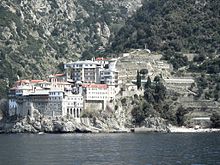Minuscule 922
| New Testament manuscript | |
 The beginning of the Gospel of Matthew | |
| Text | New Testament |
|---|---|
| Date | 12th century |
| Script | Greek |
| Now at | Osiou Gregoriou monastery |
| Size | 14.2 cm by 10.5 cm |
| Type | Byzantine |
| Category | V |
| Note | marginalia |
Minuscule 922 (in the Gregory-Aland numbering), δ 200 (von Soden),[1][2] is a 12th-century Greek minuscule manuscript of the New Testament on parchment. It has marginalia. The manuscript has survived in complete condition.
Description
The codex contains the text of the New Testament, on 405 parchment leaves (size 14.2 cm by 10.5 cm).[3] The text is written in one column per page, 28 lines per page.[3][4]
The order of books: Gospels, Book of Acts, Catholic epistles, Pauline epistles, and Book of Revelation.[5]
The text of the Gospels is divided according to the κεφαλαια (chapters), whose numbers are given at the margin, and their τιτλοι (titles of chapters) at the top of the pages.[5] There is also a division according to the smaller Ammonian Sections (in Mark 241 sections, the last section in Mark 16:20), whose numbers are given at the margin. There are no references to the Eusebian Canons.[5]
It contains tables of the κεφαλαια (tables of contents) before each of the biblical books and subscriptions at the end of each of the books (as in Codex Tischendorfianus III and Minuscule 566).[5] These subscriptions were called Jerusalem Colophon.[6]
Text
The Greek text of the codex is a representative of the Byzantine. Kurt Aland placed it in Category V.[7] It was not examined by the Claremont Profile Method.[8]
The text of the Pericope Adulterae (John 7:53-8:11) is marked at the margin by an obelus (÷) as doubtful.[5]
History

According to C. R. Gregory it was written in the 13th century. Currently the manuscript is dated by the INTF to the 12th century.[4] It was written by Constantinus, a monk. The history of the codex 922 is known until the year 1886, when it was seen by Gregory at the Osiou Gregoriou monastery, in Mount Athos.[5] The manuscript is still housed at the Osiou Gregoriou monastery (3).[3][4]
The manuscript was added to the list of New Testament manuscripts by Gregory (922e).[5] It was not on the Scrivener's list, but it was added to his list by Edward Miller in the 4th edition of A Plain Introduction to the Criticism of the New Testament.[9]
Herman C. Hoskier examined and collated its text only in the Revelation of John.[10]
It is not cited in critical editions of the Greek New Testament (UBS4,[11] NA28[12]).
See also
- List of New Testament minuscules (1–1000)
- Minuscule 897 (Gregory-Aland)
- Minuscule 1187 (Gregory-Aland)
- Biblical manuscript
- Textual criticism
References
- ^ Gregory, Caspar René (1908). Die griechischen Handschriften des Neuen Testament. Leipzig: J. C. Hinrichs'sche Buchhandlung. p. 79.
- ^ Soden, von, Hermann (1902). Die Schriften des neuen Testaments, in ihrer ältesten erreichbaren Textgestalt / hergestellt auf Grund ihrer Textgeschichte. Vol. 1. Berlin: Verlag von Alexander Duncker. p. 106.
- ^ a b c Aland, Kurt (1994). Kurzgefasste Liste der griechischen Handschriften des Neues Testaments. Berlin, New York: Walter de Gruyter. p. 102. ISBN 3-11-011986-2.
{{cite book}}: Unknown parameter|coauthors=ignored (|author=suggested) (help) - ^ a b c "Liste Handschriften". Münster: Institute for New Testament Textual Research. Retrieved 8 April 2012.
- ^ a b c d e f g Gregory, Caspar René (1900). Textkritik des Neuen Testaments. Vol. 1. Leipzig: J.C. Hinrichs. p. 232.
- ^ Alfred Schmidtke, Neu Fragmente und Untersuchungen zu den judenchristlichen Evangelein TU 37/1; Leipzig, Hinrichs, 1911, p. 3
- ^ Aland, Kurt (1995). The Text of the New Testament: An Introduction to the Critical Editions and to the Theory and Practice of Modern Textual Criticism. Grand Rapids: William B. Eerdmans Publishing Company. p. 139. ISBN 978-0-8028-4098-1.
{{cite book}}: Unknown parameter|coauthors=ignored (|author=suggested) (help) - ^ Wisse, Frederik (1982). The Profile Method for the Classification and Evaluation of Manuscript Evidence, as Applied to the Continuous Greek Text of the Gospel of Luke. Grand Rapids: William B. Eerdmans Publishing Company. p. 67. ISBN 0-8028-1918-4.
- ^ Scrivener, Frederick Henry Ambrose (1894). A Plain Introduction to the Criticism of the New Testament. Vol. 1 (4 ed.). London: George Bell & Sons. p. 276.
{{cite book}}: Unknown parameter|coauthors=ignored (|author=suggested) (help) - ^ H. C. Hoskier, Concerning the Text of the Apocalypse (London 1929), vol. I, pp. 515-516. (collation in volume 2)
- ^ Aland, B.; Aland, K.; J. Karavidopoulos, C. M. Martini, B. Metzger, A. Wikgren (1993). The Greek New Testament (4 ed.). Stuttgart: United Bible Societies. p. 18*. ISBN 978-3-438-05110-3.
{{cite book}}: CS1 maint: multiple names: authors list (link) - ^ Nestle, Eberhard et Erwin (2001). Novum Testamentum Graece (27 ed.). Stuttgart: Deutsche Bibelgesellschaft. p. 812. ISBN 978-3-438-05100-4.
{{cite book}}: Unknown parameter|coauthors=ignored (|author=suggested) (help)
Further reading
- Gregory, Caspar René (1900). Textkritik des Neuen Testaments. Vol. 1. Leipzig: J.C. Hinrichs. p. 232.
External links
- "Liste Handschriften". Münster: Institute for New Testament Textual Research. Retrieved 8 April 2013.
